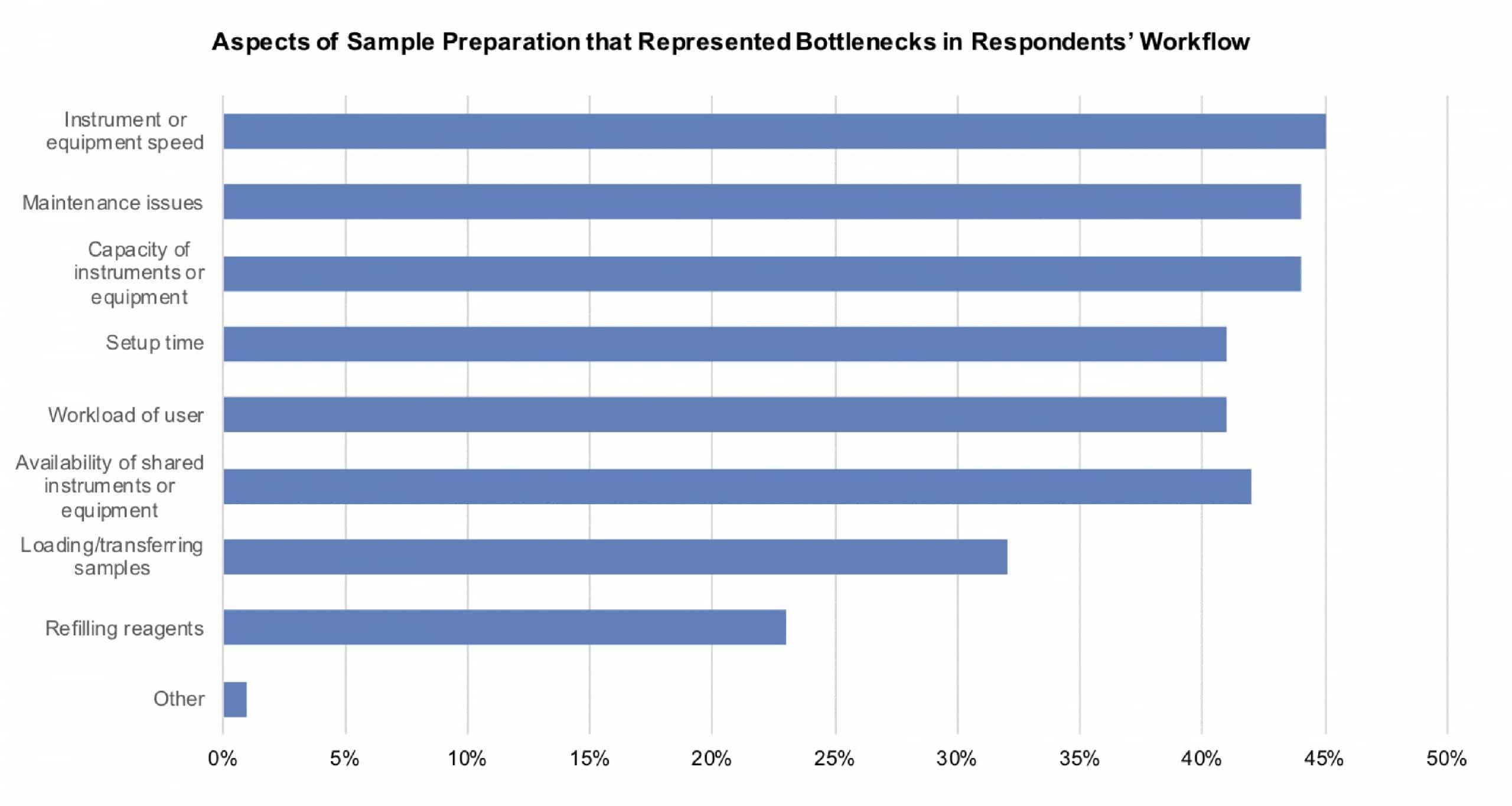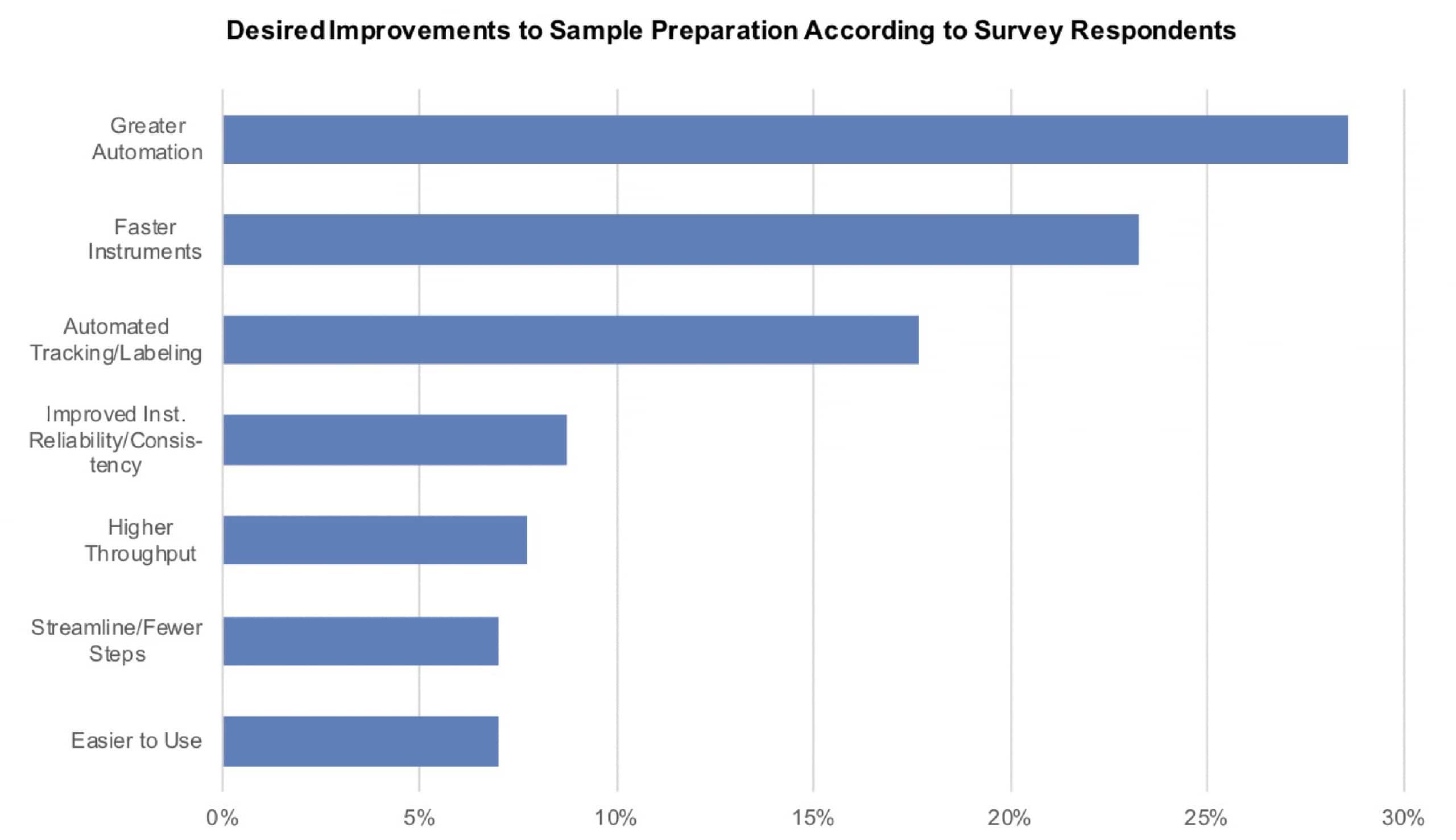Users’ Top Automated Sample Prep Needs: More Automation and Speed
Sample preparation is a necessary part of virtually any laboratory activity. As analytical instruments have advanced, their throughput capabilities have greatly increased. This means that the volume of samples processed by many labs has also grown substantially in recent years. Unfortunately, for many users, sample prep is perceived as a repetitive and time consuming task that represents a significant bottleneck in their workflows, taking up time that could be spent on their analytical work.
In April, 456 users of nucleic acid preparation, prep chromatography and various extraction techniques were surveyed for a recently released SDi report on sample preparation. Portions of the data presented here are exclusive to IBO.

Click to enlarge
Respondents were asked to select bottlenecks in their workflows that they have experienced from a list of technical and non-technical aspects of sample preparation that impede their workflows (see graph above). Most commonly identified were technical issues related to instrument design, namely sample prep instrument speed, and the sample capacity of instruments, which were each selected by nearly half of respondents.
The next leading problems were related to the laboratory, and perhaps more specifically the communal circumstances of respondents. Regular maintenance and timely repair of sample prep-related instruments seemed to be a frequent concern, cited by almost half of respondents, as was the limited availability of shared pieces of sample prep equipment.
Issues related to sample prep in an individual user’s workflow were also prominent. This was particularly true of time required for setup and the overall workload of the user. About a third of users identified the time spent loading or transferring samples in and out of instruments as a bottleneck.

Click to enlarge
In an open-answer question, respondents were asked to identify how sample preparation could be improved to enhance their overall workflows. Of the 413 respondents who provided comprehensible answers, most took this opportunity as a chance to share a wish list of solutions (see graph above). Adoption of automation is rapidly proliferating, with 52% of respondents reporting that their lab currently uses some form of automation for sample prep. The most common automated instruments already in use by respondents are liquid handlers, automated pipetters and plate handlers.
Unsurprisingly, the majority of suggestions were related to making sample prep less time consuming for the user. By far, the most commonly identified feature desired by respondents was greater automation, as indicated by 29% of respondents. Users wish to reduce the hands-on work and attention required for sample prep.
With increasingly large sample volumes being generated, automation is becoming more necessary and relied upon. However, the desire for automation was not exclusive to high-throughput users. About a quarter of respondents who wanted greater automation lamented that suitable automation solutions were not available for users with lower-throughput workflows. Most automated instruments are not designed to prepare smaller numbers of samples. While automation saves users time and work, they are not completely perfect solutions. Nine percent of respondents cited the need for improved instrument reliability and consistency.
Sample tracking and labeling was also a common wish list item. Many users want greater integration of tracking features in their instruments. Some mentioned universal label reading and internet connectivity would be appreciated for tracking samples across the various instruments used in their workflows. Several desired RFID tagging of samples.
Nearly a quarter of respondents said that faster sample prep instruments would improve their workflows. This complaint was applicable to both instruments and slow running consumables. Along the same vein, 7% desired sample prep processes that were more streamlined or which involved fewer steps.
While sample prep remains a bottleneck, there is hope among some respondents. More than a third expect that their sample prep budgets will increase over the next two years. Of these fortunate respondents, most expect increases of more than 10%. The largest expected sample prep increase was reported among users of nucleic acid prep; 35% of the nucleic acid prep users who expect larger budgets anticipate substantial increases of 20% or more for sample prep.

